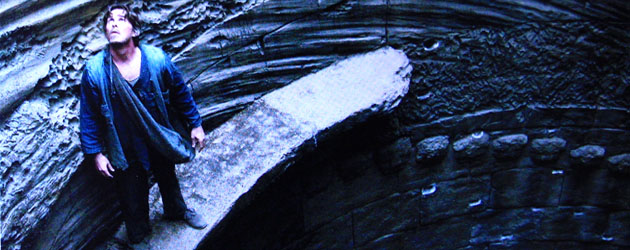Nathan Crowley

You often have to fight producers and ADs. Oh we’ll just pick up that scene while we’re over here because they’re just having a little conversation. I call it throwing away a great opportunity. Producers and ADs will say, Oh, well, it’s an eighth of a page! But some of the greatest visual scenes in film have no dialog.
Yeah, let’s throw it away. Let’s throw it away somewhere great! For me when I try to get scale in architecture I do it with real places. It’s very hard to achieve scale by building a set. You’ll never get the scale you get with real architecture. Combine the two.
AS: How do you feel about people trying to create scale by doing a small build and extending everything with CG?
NC: To me I rarely believe it. It doesn’t feel right. There’s no atmosphere in it. Like the bulbs in The Prestige. A lot of people would say you could do that digitally. We did that for real with hundreds of light bulbs in a field. And then we got fog that night. When they went on the camera operator was saying, I can’t see this! But it was the most phenomenal shot in the film. The fog gave it emotion -something unexpected that you cannot plan digitally.
AS: Someone mentioned that the Bat vehicle in The Dark Knight Rises was really sixty floors up.
NC: You put it up on the real roof in New York so when they get out of it they’re really sixty floors up. You have the conversation with Catwoman and Batman with the vehicle behind them with a real view of NYC and then you do the landing digitally. You do the taking off digitally. But you have the real thing in the real landscape with the real lighting. When you do greenscreen set extensions on a sound stage what are you matching? You’re not matching anything but artificial light on a set and a plate reference.
When we’re in the garage we just assume everything’s real and there are no VFX. That’s where we start and then we see what trouble we’re in. Obviously there are plenty of VFX shots but we try not to start in that mind set.
AS: How involved are you with designing what the Bat looks like and the various other vehicles?
NC: They’re the first things I work on. I usually design them in the garage using models. I designed all of them. It’s a great way to start a process. It’s just me and Chris. Again, he should be writing but he comes down to hover over my shoulder while I’m gluing this shit together. Do you really want to put that there? It’s like, Chris, leave me alone! He just doesn’t want to sit down and write. Like every kid he wants to be playing with model kits in the workshop.
It usually takes me five concept models to get to the final design. Usually by then all the skin on my hands is gone because of the glue. The smell of glue is so strong I have to leave the garage and go out. I design them and then I give them to my 3D guy to draw up. I’m really proud of the Batmobile, the Pod and the Bat. The Pod was the hardest thing to come up with.
AS: What would you say are the ideal characteristics a production designer should have? Is being able to make models a requirement?
NC: I always believe you should be a jack of all trades. You have to have a love of design. The love of story. You have to love film. Films like David Lean’s Great Expectations affected me. To me I get a lot of my inspiration from artists. Exhibitions. Museums. You have to be aware of the world. You should always be looking. It’s about being adventurous. How can you describe something visually? Really engage someone emotionally through visuals? How can you do that? I think my strong point is scale. Sarah Greenwood’s strong point is color. We all come to it from a different perspective.
Pingback: Rick Heinrichs